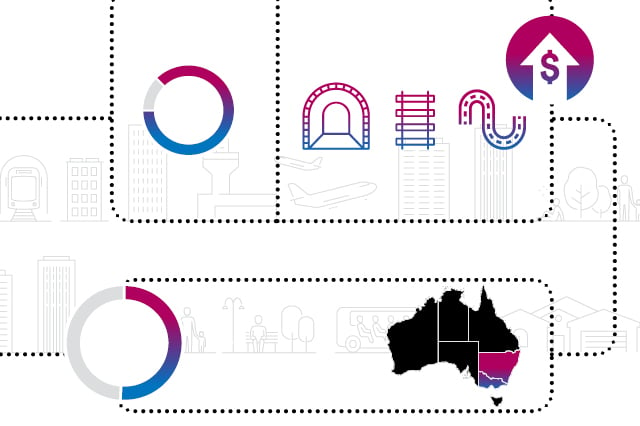Good infrastructure isn't a matter of public versus private 5 min read
For the past two decades, Australia has been a leader in the use of public private partnerships (PPPs) and private capital in the delivery of public infrastructure. Our successes have been so pronounced that countries such as Canada would send experts and civil servants to learn from local authorities. The market matured, and many complex projects were delivered using this approach. It is the combination of private and public sectors that is crucial for a successful project, allowing certain risks to be transferred, better management of risk and more innovative thinking.
In this Insight, we discuss why private sector involvement is beneficial and how they enable stronger project outcomes for all.
Key takeaways
- Good infrastructure requires both the public and private sectors.
- The private sector brings new ways of thinking that reduce risk and costs, and drive the best possible outcomes for the taxpayer, based on governments' identified needs.
- Private sector involvement unlocks innovation and improves outcomes.
- Some risks – including political risk, certain inherent project risks, the costs associated with changing needs and the ultimate responsibility for public services - will always belong to the government.
- Other risks can be more efficiently quantified, managed and accepted by the private sector.
Why are both public and private sectors needed in infrastructure?
The reality is, good infrastructure necessarily involves both the public and private sectors. When the system works well, the government acts like the board of directors. It sets the direction and determines what the public needs. The private sector then steps in to provide the workforce, finding the best way to deliver the product and the best people to do it.
No government can house world-leading tunnel engineers, traffic forecasters and acute care design experts. The breadth of infrastructure managed by governments is immense. Efficient delivery requires the public sector to draw on the expertise of the private sector to bring new ways of thinking that reduce risk and costs and, most importantly, drive the best possible outcomes for the taxpayer, based on the identified needs. The private sector brings expertise and insight that span beyond any one government or geographical area.
What are the benefits of private sector funding for government?
There are significant benefits in gaining private sector funding for projects, including:

1. Greater transfer of risk to the private sector

2. More active management of that risk

3. Private sector innovation, thinking and best-in-class outcomes
The private sector is better placed to assume and manage the bulk of the risks. It’s not a complete risk transfer but nor should it be – certain risks will always remain with government. Political risk, particular inherent project risks, the costs associated with changing needs and the ultimate responsibility for public services will always belong to the government.
Private sector input also (and perhaps more importantly) facilitates innovation and new expertise to find solutions and shoulder the risks associated with those solutions. It also provides upside for the government, as buying the most efficient and innovative solution will enhance outcomes. In the downside case, it buys some risk protection, which the private sector is more equipped to assume and manage.
Private sector involvement also yields a more diverse range of assets. Willingness to take on risk and trial new projects in all asset classes creates greater variety and supports a more balanced pipeline.
Improving outcomes, but how?
One of the first arguments against private sector involvement is always that governments can raise money more cheaply. That ignores the significant amount of risk that is transferred. The government makes a promise to repay government bondholders even if the project is a disaster. No such promise is made to private sector financiers, who are asked to look to the project for repayment.
The best evidence of the value of this risk transfer is found in our cities' project failures. It was the early investors who bore the brunt of disastrous traffic volume modelling in the early years of Sydney's Cross City Tunnel. After initial uproar, the private sector has ironed out the teething problems at the Northern Beaches Hospital. The cracking in Melbourne's CityLink tunnel was resolved at the private sector's expense. The list goes on, and the bigger and riskier the project, the more important it is to share the risk outside government.
Private investment also allows for infrastructure assets, such as ports, airports and regulated assets, to be made more efficient and profitable. The asset can be valued more highly by the private sector, which, in turn, represents additional value to the government and frees up its balance sheet to deliver more infrastructure where it's needed. With the right protections in place, the private sector's involvement represents an opportunity for the government to achieve more with less.
In real terms, the groundbreaking Victorian Comprehensive Cancer Centre would not be a landmark building if the government's reference design had been delivered; nor would we have seen the transformative vision for the Sydney Metro Martin Place Precinct, or the iconic architecture of the Sydney Opera House.
What's next?
Private sector involvement in the public sector is growing stronger and with good reason.
In the short to medium term, it allows the transfer of some financial risk and improves the management of that risk. In the long term, it unlocks innovation and improves outcomes. It also expands capacity, which is vital as we seek to drive economic growth and support the economy as it recovers from the economic shock of the recent pandemic.
By embracing public and private sector collaboration as a benchmark for good infrastructure, we can create better and more sustainable cities.
Latest thinking on infrastructure

Refocusing Australia's infrastructure pipeline
Australia's pipeline needs to be reconsidered to deliver the maximum benefits to our society and economy. Read our latest insight on how.

Collaboration is key to Australia's infrastructure-led recovery
View a quick summary of our 2020 Infrastructure Leaders Survey - key stats and recommendations.

Connected infrastructure
To unlock a sustainable future, connected infrastructure is needed to allow for real-time feedback for both governments and citizens. Read our latest thinking.
Our experience with clients
Advises on Australia's first PPP green loan
Advised the lenders on the refinancing of Canberra Metro's syndicated facility, Australia's first public-private partnership (PPP to have a certified 'green loan'.
Advises on $4.2b WestConnex refinancing
Advised the lenders on WestConnex's $4.2b refinaning, which reached financial close on 18 December 2020.
Advises on $1.5b New Footscray Hospital
Advised Multiplex on the successful close of the $1.5b New Footscray Hospital Project.




